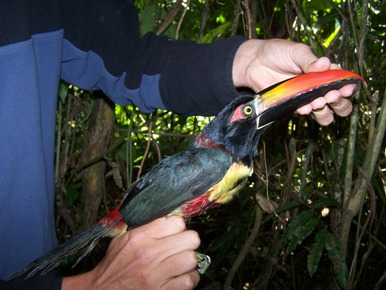- Fiery-billed Aracari
Taxobox
name = Fiery-billed Aracari
status = LC | status_system = IUCN3.1

image_width = 250px
regnum =Animal ia
phylum = Chordata
classis = Aves
ordo =Piciformes
familia = Ramphastidae
genus = "Pteroglossus"
species = "P. frantzii"
binomial = "Pteroglossus frantzii"
binomial_authority = Cabanis, 1861The Fiery-billed Aracari, "Pteroglossus frantzii", is atoucan , anear-passerine bird which breeds only on thePacific slopes of southernCosta Rica and westernPanama . The binomial commemorates the German naturalistAlexander von Frantzius .Description
Like other toucans, the Fiery-billed Aracari is brightly marked and has a large bill. The adult is typically 43 cm long and weighs 250 g.
The sexes are alike in appearance, with a black head and chest and dark olive green upperparts, apart from a red rump and upper tail. There is reddish collar on the rear neck. The underparts are bright yellow, with a round black spot in the centre of the breast and a red band across the belly. The thighs are chestnut.
The bare facial skin is black, becoming ruddy behind the yellow eye. The upper mandible of the bill is bright orange, the lower mandible is black, and the legs are green.
Juvenile Fiery-billed Aracaris are much duller, with sooty-black head and brownish green upperparts. The red rump and yellow underparts are paler, and the breast spot, belly band and bill pattern are indistinct.
This species is similar to the closely-related
Collared Aracari , "Pteroglossus torquatus", with which it is sometimes considered conspecific. It differs from Collared in the orange upper mandible, red belly band, and larger dark breast spot.The call of the Fiery-billed Aracari is a loud, sharp "pseek", or "keeseek", similar to that of Collared, but more often two-noted.
Behaviour
Small flocks, usually consisting of up to 10 birds, move through the forest with a rapid direct flight. This species is primarily an arboreal fruit-eater, but will also take
insect s,lizard s, bird eggs, and other small prey.Reproduction
The Fiery-billed Aracari is a common resident breeder in lowland forests and clearings. The two white eggs are laid in an old
woodpecker nest, 6-30 m high in a tree. Both sexes incubate the eggs for about 16 days, and the toucan chicks remain in the nest after hatching. They are blind and naked at birth, and have short bills and specialised pads on their heels to protect them from the rough floor of the nest. They are fed by both parents, assisted by up to three other adults, probably from a previous brood, and fledge after about 6 weeks, with feeding by the adults continuing for several weeks after leaving the nest.The
aracari s are unusual for toucans in that they roost socially throughout the year, up to five adults and fledged young of this species sleeping in the same hole with their tails folded over their backs.References
* Database entry includes justification for why this species is of least concern
* "A guide to the birds of Costa Rica" by Stiles and Skutch ISBN 0-8014-9600-4External links
* [http://www.diostede.com/collared_aracari_toucan/natural_history_literature/pteroglossus_torquatus_frantzii_fiery_billed_aracari.html Bibliography] of online, ornithological articles which explore the natural history of the Fiery-billed aracari, "Pteroglossus torquatus frantzii".
* [http://ibc.hbw.com/ibc/phtml/especie.phtml?idEspecie=3719 Fiery-billed Aracari videos] on the Internet Bird Collection
* [http://vireo.acnatsci.org/search.html?Form=Search&SEARCHBY=Common&KEYWORDS=fiery-billed+aracari&showwhat=images&AGE=All&SEX=All&ACT=All&Search=Search&VIEW=All&ORIENTATION=All&RESULTS=24 Fiery-billed Aracari photo gallery] VIREO [http://vireo.acnatsci.org/species_image.php?species=Pteroglossus+frantzii Photo-High Res]
* [http://tropicalhardwoods.com/htm/tree_owners_news/photos/19_fall_2004/aracari.jpgPhoto-High Res--Perched bird]
Wikimedia Foundation. 2010.
